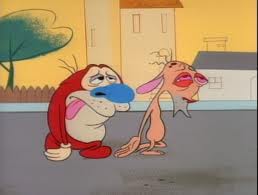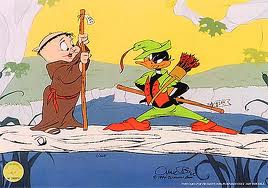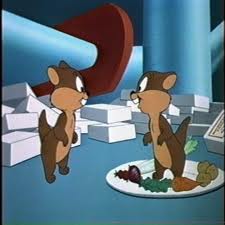I’ve recently read a couple of posts on other blogs about 2 man comedy teams.
The first was Pretty Clown, Ugly Clown by Anthony Balducci. It is a look at some interesting combinations of actors in movies.
The second post, Odd Couples by John Towsen is about some lesser known comedy pairings from the stage.
For animators, the idea of a comedy duo usually starts with the simple idea of Fat Guy/Skinny Guy like Laurel and Hardy, and Abbot and Costello. But really, the physical appearance won’t take the work very far. There needs to that special chemistry that creates contrast. Tex Avery is often remembered for his wacky wolf character. But it was the second wolf who was smooth and debonair who completed the scene.

Tex also created the ever calm Droopy Dog, but Droopy always played against a high energy partner:

The dysfunctional friends Ren and Stimpy had one of the more complex relationships in animation. More like a classic comedy team. They were real partners, sharing in each other’s lives, but each had very different personalities, and were often at odds.

When Porky Pig and Daffy Duck worked together, they were somewhat similar to the classic team. While they weren’t enemies, they weren’t pals either.

Another classic way to put two characters together is the star/sidekick team, such as Yogi Bear and Boo Boo. Wallace and Gromit, due to their owner/dog relationship can be considered an evolved example of this. While the sidekick is often the smarter of the two, the star is the character who causes the action. I’m thinking that Rocky & Bullwinkle fall into this category.

I suppose it’s possible to consider a pair of antagonists to be a comedy team. In fact, it may be the most common kind found in cartoons. You have your Roadrunner and Coyote, Tom and Jerry, Bugs and Elmer, Sylvestor and Tweety, Foghorn Leghorn and George P. Dog. Those arrangements obviously have a predator/prey relationship with the predator usually getting the worst of the situation. Still, each has unique characters that carry out their parts in their own style.

Comedy teams don’t always have to be in contrast with each other. Animation has the unusual combination of two characters that are very similar, such as Chip n’ Dale, and Heckle and Jeckle. These characters always work as a team to harrass a third character.

Mac and Tosh were a pair of gophers who premiered in the Bob Clampett short, Goofy Gophers. They played against a dog character. Here is a bit of trivia from wikipedia:
The gophers’ mannerisms and speech were patterned after Frederick Burr Opper‘s comics characters Alphonse and Gaston, which in the early 1900s engendered a “good honest laugh”. The crux of each four-frame strip was the ridiculousness of the characters’ over-politeness preventing their ability to get on with the task at hand.
The pair’s dialogue is peppered with such over politeness as “Indubitably!”, “You first, my dear,” and “But, no, no, no. It must be you who goes first!” The two often also tend to use unnecessarily long words, for example, in Lumber Jerks, instead of “We gotta get our tree back”, they say “We must take vital steps to reclaim our property.” Clampett later stated that the gophers’ effeminate mannerisms were derived from character actors Franklin Pangborn and Edward Everett Horton.


What about comedy teams that are a man and a woman?
Love your blog! Another great post! I’m just an animation fan, but a professional clown and clown teacher and this comes up a lot. I had some thoughts I thought I’d share. The comic duo is the personification of setup and punchline. Often called straight man/funny man, though just as easily straight person/funny person. Though that’s still a misnomer because punchlines aren’t funny without their setups and both partners are working together for the laugh that both achieve equally even if it occurs after one line and not another. In his course and the book based on it, “The Hidden Tools of Comedy,” Steve Kaplin redefines this dynamic as straight line/wavy line. But wavy line doesn’t always equal what was formally funny person. In clown training, there are differing names as well, but duos are often called Joey and Auguste. Or the Whiteface clown and Auguste. Regardless this pairing goes back earlier than vaudeville and is based on status. Status, not as in class status, but as in higher and lower status in relationship to something else. Can be another person or even an object. And it’s fluid. There’s a really excellent chapter on status in improv guru Keith Johnstone’s book “Impro: Improvisation and the Theatre.”